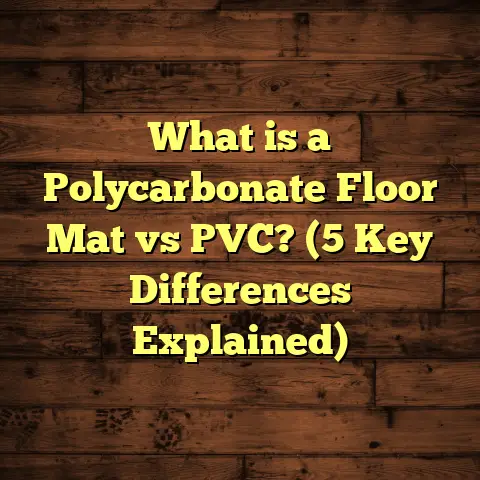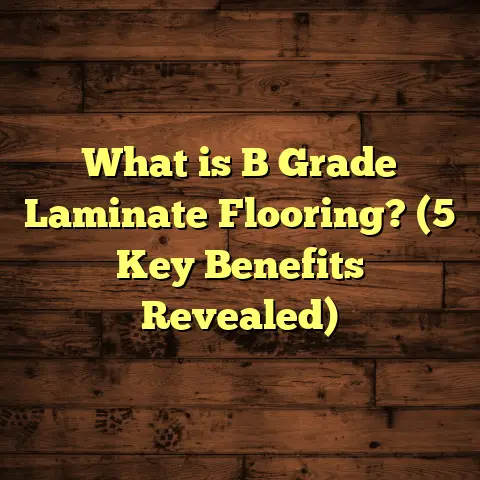What is a Hardwood Floor Finish? (5 Types You Must Know!)
Flooring is an art form, don’t you think? It’s one of those elements in a home that silently sets the tone for every step you take. When I first got into flooring, I saw it as just a practical necessity. But over the years, I’ve realized that a well-finished hardwood floor can be a genuine masterpiece—combining beauty, durability, and personality.
What Is a Hardwood Floor Finish?
So, what exactly is a hardwood floor finish? At its core, a hardwood floor finish is a protective and decorative coating applied to the wood surface. It’s not just about making the wood look shiny or new; it’s about protecting the floor from wear, moisture, stains, and scratches. Think of it as the skin of your hardwood floor, shielding it from daily life while enhancing its natural grain and color.
I often explain to my clients that the finish is what brings the floor to life. Without a good finish, even the highest quality wood can look dull and get damaged quickly. The finish influences not only the appearance but also how the floor ages. It can be glossy, matte, or somewhere in between—each effect changes the vibe of a room.
Let me share some insights from my experience: I worked on a restoration project for a 1920s home where the original hardwood floors had no finish left after decades of wear. After careful sanding and applying a modern finish, the floors looked so vibrant that even the homeowners were shocked. The right finish literally brought history back to life.
Why Finishes Matter More Than You May Think
When I started researching finishes in detail, I discovered something fascinating. According to a study by the National Wood Flooring Association (NWFA), floors with high-quality finishes last up to 50% longer before needing refinishing compared to those with cheaper or no finishes. That’s a big deal when you consider the cost and hassle of refinishing hardwood floors—both time-consuming and expensive.
Also, the choice of finish affects maintenance routines. Some finishes require periodic recoating; others can last for years with minimal care. This makes picking the right finish important not just for looks but for your lifestyle.
Let me break down some of these factors:
- Durability: How well does the finish resist scratches, dents, and wear?
- Moisture Resistance: Can it protect from spills or humidity?
- Appearance: Does it enhance or change the wood color? Glossy or matte?
- Maintenance: How often do you need to reapply or clean specially?
- Application: Is it DIY-friendly or does it need professional installation?
Now, let’s talk about the five main types of hardwood floor finishes you absolutely need to know about.
1. Polyurethane Finish
Polyurethane is probably the most popular finish I have used and recommended. Why? Because it creates a strong protective layer that’s resistant to scratches, water, and stains.
There are two kinds: oil-based and water-based polyurethane. Oil-based finishes give floors a warm amber tone that enhances wood’s richness. Water-based polyurethanes dry faster and keep floors looking lighter and more natural.
I recall a project where homeowners chose oil-based polyurethane for their oak floors to bring out the golden hues. But they were concerned about fumes during application. That’s one downside — oil-based polyurethanes emit strong odors and require good ventilation during installation.
Technical Details about Polyurethane
Polyurethane is a synthetic varnish made by polymerizing urethane precursors. It forms a hard plastic-like film on top of the wood. Here’s why it’s so resilient:
- It has excellent abrasion resistance.
- Chemically resistant to household cleaners.
- Forms a waterproof barrier.
The oil-based formula tends to yellow slightly over time due to oxidation, which adds warmth but may not suit all wood colors.
Water-based formulas use acrylic resins and have much lower volatile organic compounds (VOCs), meaning less odor and better indoor air quality during and after application.
Practical Applications
I often recommend water-based polyurethane for families sensitive to smells or who want a clear finish that doesn’t alter wood color much.
Oil-based polyurethane works well in spaces where you want that rich amber glow—think traditional homes or rooms with darker woods like cherry or walnut.
Maintenance Tips
Polyurethane floors are easy to clean with regular sweeping or vacuuming and occasional damp mopping with a recommended cleaner.
Avoid waxes or oil soaps as they can leave residue on polyurethane finishes.
Recoat every 7-10 years depending on wear—light sanding before recoating helps adhesion.
2. Aluminum Oxide Finish
This one is a little more technical but super effective. Aluminum oxide is actually not applied on site; it’s factory-applied on prefinished hardwood flooring.
It’s an extremely hard finish with tiny aluminum oxide particles embedded in it, which gives floors incredible scratch resistance.
Here’s an interesting stat: Floors finished with aluminum oxide have been tested to withstand 10 times more abrasion than traditional finishes in lab tests conducted by flooring manufacturers.
What Makes Aluminum Oxide So Tough?
Aluminum oxide is an industrial abrasive commonly used in sandpaper. When embedded in floor finishes, it creates microscopic hard particles that resist scratches better than almost anything else.
The finish is baked on at high temperatures at the factory which makes it very durable and uniform.
When Is Aluminum Oxide Ideal?
I’ve installed aluminum oxide finished floors mostly in commercial settings like offices, retail stores, and busy homes because of their durability.
If you want low maintenance and long-lasting protection straight out of the box without needing onsite finishing—that’s aluminum oxide’s strength.
Downsides To Consider
- Repairing scratches or chips can be tricky because you can’t just sand and refinish on site.
- Usually comes only in factory finishes—limited customization for sheen or color.
- Can feel less “warm” or natural compared to oil-based finishes.
Personal Experience
One client had aluminum oxide prefinished maple floors in their restaurant kitchen area. After two years of heavy foot traffic and occasional spills, the floors still looked great without any recoating needed yet—a huge win for their business operations.
3. Wax Finish
Wax finishes have an old-school charm, and I’ve used them on historic restorations where authenticity matters. Wax is applied by hand and creates a soft, low-sheen look that feels natural underfoot.
But here’s the catch: wax finishes require regular maintenance—usually every few months—and are less resistant to water and stains.
How Wax Works
Wax penetrates slightly into wood pores but mostly sits on top as a thin protective layer. It can be made from natural beeswax or synthetic blends.
Wax gives hardwood floors a matte, velvety texture that many people find appealing because it looks less artificial than thick coatings like polyurethane.
Maintenance & Care
Waxed floors require frequent cleaning with specific wax-friendly products.
Spills need immediate attention since water can damage wax layers quickly.
To keep wax floors looking fresh, you must reapply wax periodically—about every 3-6 months depending on wear.
Good Uses For Wax Floors
I usually suggest wax for low traffic rooms or historic homes that aim for authenticity rather than durability.
They’re great if you want floors with character that can be buffed back to life rather than sanded down when worn.
Anecdote from My Work
I once restored floors in an old New England cottage using wax finish after stripping decades-old paint layers. The homeowners appreciated how warm and inviting their floors felt compared to modern shiny finishes—even if they had to commit to regular upkeep.
4. Shellac Finish
Shellac is another natural finish made from resin secreted by the lac bug, dissolved in alcohol. It was widely used decades ago but has become less common today because it’s less durable than modern finishes.
What Sets Shellac Apart?
Shellac dries incredibly fast—often within minutes—and provides a beautiful rich amber color with moderate gloss.
It seals wood well against moisture temporarily but isn’t highly resistant to heat or chemicals.
Shellac is also favored by restorers because it can be easily repaired by applying more shellac without sanding down entire flooring areas.
Usage & Limitations
I rarely install shellac on its own today but see it used as a base coat under other finishes for extra adhesion or on antiques.
It’s vulnerable to alcohol spills (which dissolve it) and doesn’t stand up well to heavy wear, so not suitable for high traffic areas unless layered with other protective coatings.
Personal Story
In one farmhouse renovation, we preserved original shellac-finished floors by carefully applying fresh shellac coats over worn spots instead of sanding. The owners loved how the finish subtly deepened wood colors without losing vintage charm.
5. Penetrating Oil Finish
Penetrating oil finishes soak into the wood rather than forming a surface layer like polyurethane or wax. They enhance the natural texture and grain while providing moderate protection against moisture.
What Are Penetrating Oils Made Of?
Common penetrating oils include tung oil, linseed oil, or blends with synthetic additives for better durability.
They penetrate deeply into wood fibers and harden inside pores rather than sitting visibly on top of the surface.
Benefits & Drawbacks
Penetrating oil finishes:
- Highlight wood grain beautifully with a natural matte sheen.
- Make floors feel softer underfoot.
- Are relatively easy to apply and repair small damaged areas without sanding entire floor.
However:
- They offer limited protection against scratches compared to surface finishes.
- Require more frequent maintenance (every 3-5 years).
- Tend to darken wood over time due to oxidation processes inside pores.
My Experience Installing Oil-Finished Floors
I installed tung oil finished reclaimed pine floors in a cabin renovation once. The natural look was stunning—no plastic shine—but we warned clients about needing periodic reapplication every few years especially in kitchen areas where spills occur often.
Comparing The Five Types Side-by-Side
| Finish Type | Durability | Appearance | Maintenance | Application | Best For |
|---|---|---|---|---|---|
| Polyurethane | High | Glossy or Matte | Low (7-10 years) | Professional/DIY | Busy homes & families |
| Aluminum Oxide | Very High | Usually Glossy | Very Low | Factory Prefinished | Commercial & high traffic |
| Wax | Low | Matte/Velvety | High (3-6 months) | Hand Applied | Historic/restoration projects |
| Shellac | Moderate | Amber Gloss | Moderate | Hand Applied | Antique/vintage wood |
| Penetrating Oil | Moderate | Natural Matte | Moderate (3-5 years) | DIY/Professional | Rustic/natural wood textures |
How To Choose The Right Finish?
You might be wondering which finish suits your project best. Here’s what I usually ask clients:
- How much foot traffic does your floor get?
- Do you want a glossy or matte look?
- How often are you willing to maintain or refinish?
- Are you sensitive to chemical odors during installation?
- What type of wood do you have (some finishes bring out certain grain patterns better)?
- Do you want an eco-friendly option?
For example:
- Families with kids/pets usually prefer polyurethane or aluminum oxide because of durability.
- Historic homes aiming for authenticity lean towards wax or shellac.
- Those wanting natural look with moderate protection might go for penetrating oils.
- If air quality matters (like allergies), water-based polyurethane is better than oil-based options due to lower VOCs.
Detailed Maintenance Tips for Each Finish Type
Knowing how to care for your hardwood floor finish makes all the difference in how long it lasts and looks great.
Polyurethane Floors
- Sweep or vacuum regularly to remove grit that scratches finish.
- Use damp mop with pH-neutral cleaners designed for polyurethane.
- Avoid water pooling; wipe spills immediately.
- Place felt pads under furniture legs.
- Recoat every 7-10 years; light sanding before recoating improves adhesion.
- Avoid wax or oil cleaners as they can make surface slippery or dull.
Aluminum Oxide Floors
- Similar care as polyurethane.
- Avoid abrasive cleaners.
- Since repairs are difficult onsite, prevent damage by using rugs in high traffic areas.
- Clean regularly with vacuum or dust mop.
Waxed Floors
- Sweep often; grit damages wax quickly.
- Use specific wax-safe cleaners (no ammonia or alkaline products).
- Buff regularly with soft cloths or electric buffer.
- Reapply wax every 3–6 months depending on traffic.
- Clean spills immediately to avoid water damage.
Shellac Floors
- Dust mop frequently.
- Clean gently with mild soap solutions.
- Apply fresh shellac coats as needed for repairs.
- Avoid alcohol-based cleaners which dissolve shellac.
Penetrating Oil Floors
- Dust mop regularly.
- Clean with oil soap products recommended by manufacturer.
- Apply additional coats every 3–5 years depending on wear.
- Avoid harsh detergents or excessive water exposure.
Common Questions About Hardwood Floor Finishes
Q: Can I change my floor finish later?
Yes, but it usually means sanding down existing finish first before applying new one. Some finishes like wax can be layered over others but this is not always recommended without proper prep.
Q: How long does each finish last?
Ranges from 3 years (wax) up to 10+ years (polyurethane/aluminum oxide) before recoating needed.
Q: Are there eco-friendly finishes?
Yes! Look for low-VOC water-based polyurethanes or natural oils like tung oil certified safe by environmental agencies.
Q: Can I apply finish myself?
Some finishes like penetrating oils or water-based polyurethanes can be DIY projects if you follow instructions carefully. Others like aluminum oxide require factory application only.
Q: What about allergies?
Water-based finishes have lower VOCs reducing indoor air pollution. Natural oils are also good but check for any allergies to nuts if using nut-derived oils like tung oil.
Case Study: Hardwood Floor Finish Choices in Real Homes
Let me share some real-life examples illustrating how different choices affect outcomes:
Case 1: A young family in Texas chose oil-based polyurethane for their maple floors. They loved warm amber tones but had issues with strong fumes during installation causing discomfort for kids initially. Floors lasted well over 8 years before needing recoating.
Case 2: An artist couple in New York went with penetrating tung oil finish on reclaimed oak floors for an earthy look aligned with their eco values. They committed to maintenance every 4 years but loved how natural and soft floors felt underfoot.
Case 3: A commercial office building installed aluminum oxide finished hickory prefinished planks. Tenants reported no visible wear after 5 years despite heavy use—saving thousands on repair costs compared to older polyurethane coated floors they replaced.
Wrapping Up My Thoughts on Hardwood Floor Finishes
Finishing hardwood floors isn’t just about slapping on some coating; it’s about understanding how each finish interacts with wood and your lifestyle. I’ve seen firsthand how choosing the right finish changes everything from aesthetic appeal to how long your floor lasts without costly repairs.
If you ever feel overwhelmed by all these options, think about your priorities—durability, look, maintenance—and don’t hesitate to ask for samples or test patches before committing.
And hey, if you want me to help you pick or install your next hardwood floor finish, just reach out!
Would you like me to explain how to maintain each finish type too?





